Padi Kavali Maha Dwara
The Padi Kavali Maha Dwara or Outer Gopuram stands on a quadrangular base.
Its architecture is that of the later Chola period. The inscriptions on the gopuram belong to 13th century. There are a number of stucco figures of Vaishnava gods like Hanuman, Kevale Narasimha and Lakshmi Narasimha on the gopuram.
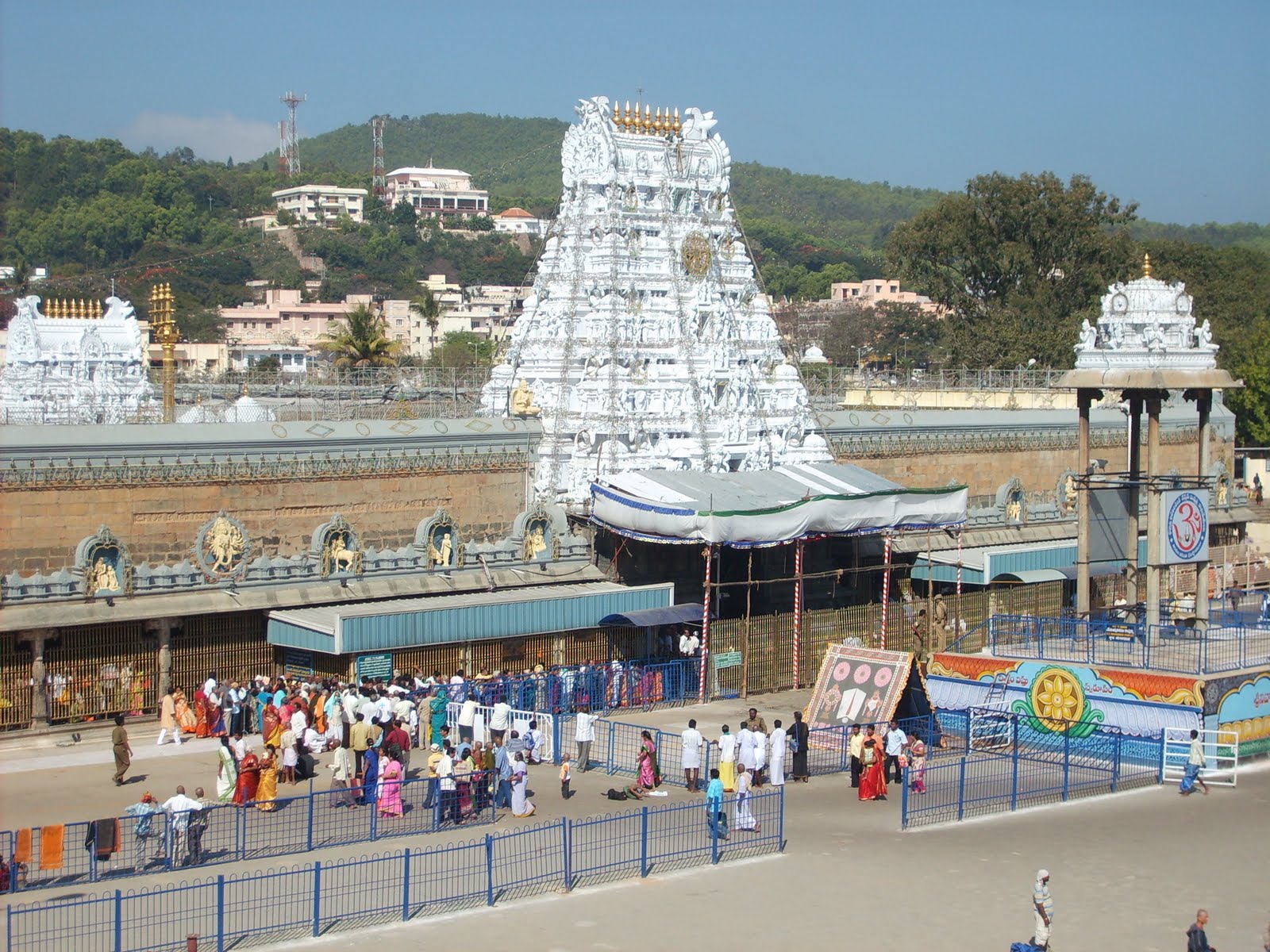
Sampangi Pradakshinam
The path for circumambulating the temple is called a pradakshinam. The main temple has three prakarams. Between the outermost and middle prakarams is the second pathway for circumambulation known as the Sampangi Pradakshinam. Currently, this pathway is closed to pilgrims.
The Sampangi Pradakshinam contains several interesting mandapams like the Pratima Mandapam, Ranga Mandapam, Tirumala Raya Mandapam, Saluva Narasimha Mandapam, Aina Mahal and Dhvajasthambha Mandapam. Krishna Deva Raya Mandapam
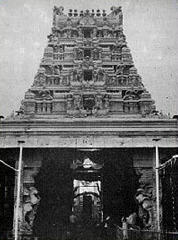
After passing through the Padi Kavali Maha Dvara, you will find yourself in an open mandapam called the Krishna Deva Raya Mandapam or Pratima Mandapam. This mandapam gets its name from the pratimas or bronze portrait icons of the Vijayanagara emperor Krishnadevaraya and his two consorts, Tirumaladevi to his left, and Chinnadevi to his right. All three icons face the main shrine, with their hands joined in supplication.
In the southern wing of the Mandapam, is a statue of Venkatapathi Raya of the Aravidu dynasty, who ruled over Chandragiri around 1570 AD. To its side are stone statues of Achyutha Raya, who succeeded Krishna Deva Raya to the throne, and his wife Varadajiamma.
This Mandapam is believed to be built in later Vijayanagara times (early half of the 16th century). This Mandapam is full of exquisitely beautiful pictures of the Vijayanagara period like, Rama breaking the bow, Rama Pattabhishekam and Krishna Leela.
Sri Vaishnava symbols or the Urdhvapundras flanked by a conch and disc are carved at the top of the two main pillars of the Mandapam.
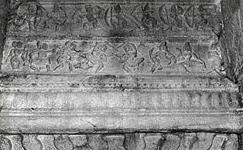
Ranga Mandapam,
also called the Ranganayakula Mandapam, is located in the south-eastern corner of the Sampangi Pradakshinam. The shrine within it is believed to be the place where the utsava murti of Lord Ranganadha of Srirangam was kept during the 14th century, when Srirangam was occupied by Muslim rulers.
It is said to have been constructed between 1320 and 1360 AD by the Yadava ruler Sri Ranganadha Yadava Raya. It is constructed according to the Vijayanagara style of architecture.
Tirumala Raya Mandapam
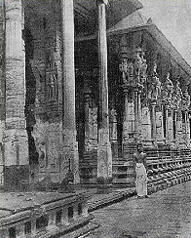
Adjoining the Ranga Mandapam on the western side, and facing the Dhvajasthambha Mandapam is a spacious complex of pavilions known as the Tirumala Raya Mandapam or Anna Unjal Mandapam.
It consists of two different levels, the front at a lower level and the rear at a higher. The southern or inner portion of this Mandapam was constructed by Saluva Narasimha in 1473 AD to celebrate a festival for Sri Venkateswara called Anna Unjal Tirunal. This structure was extended to its present size by Araviti Bukkaraya Ramaraja, Sriranga Raja and Tirumala Raja.
It is in this Mandapam, that the utsava murthi Malayappan, holds His annual darbar or Asthanam during the hoisting of the Garudadhwaja on Dhwajastambham to mark the commencement of Brahmotsavam. Incidentally, the prasadam distributed on this occasion is still called Tirumalarayan Pongal.
The Mandapam has a typical complex of pillars in the Vijayanagara style, with a central pillar surrounded by smaller pillars, some of which emit musical notes when struck with a stone. The main pillars have rearing horses with warriors mounted on them. Some of the best sculptures of the temple are found in bold relief in the Mandapam. The bronze statues of Todermallu, his mother Matha Mohana Devi and wife Pitha Bibi, are kept in a corner of the Mandapam.
Aina Mahal
The Aina Mahal is on the northern side of the Tirumala Raya Mandapam. It consists of two parts – an open mandapam in the front consisting of six rows comprising six pillars each, and a shrine behind it consisting of an Antarala and Garbhagriha.
It has large mirrors which reflect images in an infinite series. There is an unjal in the middle of the room in which the Lord is seated and festivals conducted.
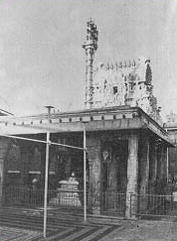
Dhwajasthambha Mandapam
The Dhwajasthambha Mandapam houses the Dhwajastambha (a wooden flagpole encased in gold) and the Bali Peetha (seat for food offering).
A peculiar feature of the Mandapam is that it is covered (unlike in other temples) to facilitate the conduct of rituals in all weather conditions.
The relative positions of the Dhwajasthambha and the Bali Peetha are in accordance with Vaikhanasa Agamic traditions.
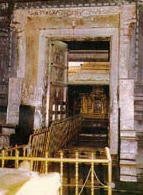
The Nadimi Padi Kavali
It is the inner gopuram in the inner entrance to the temple, which is reached through the Dhvajasthambha Mandapam.
Its wooden doors are covered with silver plates, and therefore it is also referred to as the Vendi Vakili. The doors are smaller than that of the outer gopuram.
There are numerous inscriptions on the inside walls, the earliest relating to the Pandyan monarch, Jata Varma Sundarapandya, who became king in 1251 AD.
Vimana Pradakshinam
The Vimana Pradakshinam is the commonly-used circumambulatory pathway around the central shrine. The vimana over the sanctum can be seen from this pathway. Pilgrims who have taken a vow of performing Angapradakshinam perform it in the Vimana Pradakshinam.
Sri Varadarajaswami Shrine
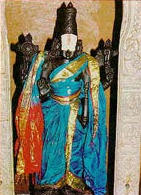
The shrine of Sri Varadarajaswami is an independent shrine located on the eastern side of the vimana. The deity of Sri Varadarajaswami faces the West and is in a standing posture, with a disc and conch in the upper right and left hands respectively. The lower right hand is in the Abhaya pose and the lower left, in the Katyavalambika pose. The name Varadaraja is given to this form of Sri Maha Vishnu as he is believed to be the giver of boons.
Potu
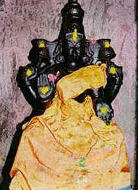
The Potu or main kitchen where the food-offerings for the main temple are prepared is located to the south of the Varadarajaswami shrine.
Inside the Potu, there is a small shrine dedicated to Sri Maha Lakshmi, who is also called Potu Amma (lady of the kitchen) or Madapuli Nachiyar. She is identified with Vakulamalika, who was, according to the Puranas, sent by Varahaswami to be the house-keeper of Sri Venkateswara, when he resided on the hill. Vakulamalika is said to have arranged Lord Sri Venkateswara’s marriage with Padmavathi.
In reality, she is regarded as Sri Maha Lakshmi, and is worshipped as such. She is worshipped during Varalakshmi Vratam, in the month of Sravana.
There is a similar icon of Sri Maha Lakshmi in the Padi Potu, another kitchen located in the Sampangi Pradakshinam.
Rice prasadam is prepared in the inner Potu, while other Panyarams like laddus, vadas appams etc., are prepared in the Padipotu.
The Main Shrine
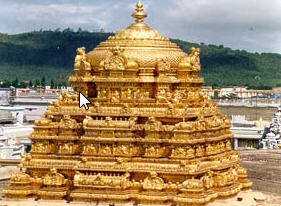
The main shrine includes the sanctum and the three successive halls in front of it upto the Bangaru Vakili. It consists of Snapana Mandapam, a square hall. Ramar Meda, a rectangular hall. Sayana Mandapam, rectangular in shape, where the Ekanta Seva is performed. Sanctum or Garba Griha, in which the deity of Lord Sri Venkateswara stands. In between the sanctum and the Sayana Mandapam, is the celebrated threshold, called the Kulasekhara-padi.
Sankeertana Bhandara
Adjoining the porch of Bhashyakara Sannidhi on its western side, is a small room called Talapakamara or Sankeertana Bhandara. It was constructed to preserve the collection of sankeertanas composed by the Talapaka poets (Talapaka Annamacharya, his son Pedda Tirumalacharya and grandson Chinna Tirumalacharya), who were minstrels attached to the hill shrine.
Annamacharya, the greatest of the three poets, came to the hill shrine in 1424 AD and served the Lord by rendering songs that he had composed, during some sequences of worship. He was a senior contemporary of Purandara Dasa, and his songs mark a significant stage in the evolution of South Indian music.
His songs can be classified into three groups – Adhyatama Sankeertanam, Sringara Sankeertanam and Srungara Manjari.
The songs were preserved in the Talapakamara for more than four hundred years, before they were transferred to the TTD office in Tirupati for the preparation of transcripts for publication during the days of the last Mahant, Prayaga Das, at the instance of the TTD epigraphist, Sri Sadhu Subramania Sastry.
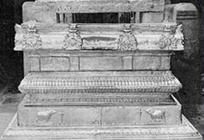
Bangaru Bavi
In front of the Potu is a well called the Bangaru Bavi. The site of the Bangaru Bavi is as directed in the Vaikhanasa Agamas, and it is constructed according to the Vijayanagara style of architecture.
Snapana Mandapam:
The Snapana Mandapam is also called the Tiruvilankovil. It has four central pillars, which bear sculptures like those of Bala Krishna, Yoga Narasimha and Kaliayamardhana.
A particularly impressive sculpture in bas relief is that of Sri Maha Vishnu in the seated pose. He is shown with four arms; the upper arms holding the chakra and the shankha.
The Lord’s consorts are also shown seated in Sukhasana on either side of him.
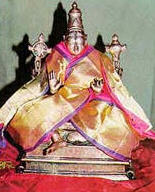
Ramar Meda,
It means ‘the elevated platform for Rama’, used to house the icons of Rama, Sita and Laxmana. These icons have since been moved to the sanctum.
The images of Vishvaksena and Garuda are the utsava murthis of their respective sub-shrines.
Sayana Mandapam
The Sayana Mandapam, also called the Ardha Mandapam, is directly in front of the sanctum (in accordance with the Agamas). This is as close to the sanctum that the pilgrims can get. The Mandapam is connected to the sanctum by the threshold called Kulasekhara-padi, after an Alwar who wished to be reborn as the threshold to the Lord’s shrine.
The main function of this Mandapam is to facilitate the performance of rituals that cannot be accommodated in the sanctum. The Mandapam is so called because it is here that the representative icon of the Lord (Bhoga Srinivasa) is ceremoniously put to bed as the last sequence (Sayanotsava or Ekanta Seva) of daily worship.
Garbha Gruha

The Garbha Gruha or sanctum is where the main deity of Lord Sri Venkateswara resides.
The deity stands majestically in the Garbha Gruha, directly beneath a gilt dome called the Ananda Nilaya Divya Vimana.
This exquisitely-wrought deity called the Mulaberam, is believed to be self-manifested, as there has been no known sculptor possessing the capability to sculpt deities so proportionately and beautifully. Further, no human being is known to have installed it in the shrine.
Ordinarily, the Lord wears a gold kiritam which has a large emerald embedded in front. On special occasions, he is adorned with a diamond kiritam.
On his forehead, the Lord has a thick double patch of upwrought namam drawn with refined camphor, which screens his eyes. In between the two white patches is a kasturitilakam.
His ears are bedecked with shining golden makara kundalas. The fist of His raised right hand is implanted with a gem-set chakra, and the corresponding left fist with the sankhu. The slightly outstreched front right hand, has its fingers pointing to His lotus feet. His front left hand is akimbo to assure His devotees of protection, and to show that the samsara sagara is only hip-deep if they seek His refuge.
His body is clothed with a pitambaram tied with gold string, and a gold belt to which are attached tiny, jingling gold bells. He is adorned with precious ornaments. He has a yajnopavita flowing down cross-wise from His left shoulder. He bears Sri Lakshmi Devi on His right chest and Sri Padmavathi Devi on His left chest. He bears Nagabharanam ornaments on both shoulders.
His lotus feet are covered with gold frames and decked with clinging gold anklets. A strong curved belt of gold encompasses his legs.
During Abhishekam, we can have darshan of Goddess Lakshmi.
The Ananda Nilaya Divya Vimana was covered with gilt copper plates and surmounted with a golden vase, in the thirteenth century, during the reign of the Vijayanagara king, Yadava Raya.
Pilgrims are not allowed to enter the Garbha Gruha (beyond Kurasekara path)
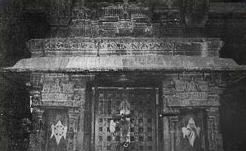
Kalyana Mandapam
Kalyanotsavam or marriage festival is celebrated in the Kalyana Mandapam.
The Kalyana Mandapam is architecturally similar to the Tirumala Raya Mandapam. At its western end, is a small mandapam carried on slender cut-stone pillars and surmounted by a vimana.
On the South of the shrine is a raised portion called the Yagasala where homams are performed in connection with Brahmotsavam and other festivals.
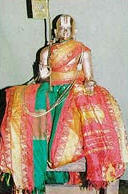
Sri Ramanuja Shrine
Adjacent to the Sangeeta Bhandara in the northern corridor of the Vimana Pradakshinam is the shrine of Sri Ramanuja, the great Vaishnava Acharya. It is also called the Bhashyakara Sannidhi.
Ramanuja was the architect of Tirupati and the father of the Sri Vaishnava community there. He designed the Nandanavanams or flower gardens of the temple. He was mainly responsible for managing the worship procedures and other affairs of the Sri Venkateswara temple.
The shrine was built around the 13th century. It overlooks the western end of the Tirumamani Mandapam. The Pandyan emblem of two fish and a hook is carved on the wall next to the entrance.
The right hand of the stone image of Ramanuja is held in the gesture of exposition (vyakhyana mudra), and the left hand in the form of boon bestowal (varada hasta), or of holding a book (pustaka hasta).
The shrine figures prominently during the festival of Adhyayanotsavam, which is a typical Pancharatra observance. Special worship is conducted in this shrine during Gandhapodi Utsavam and Bhashyakara Utsavam. The utsava murthi of Ramanuja is taken in a grand procession to meet Malayappa near the Padi Kavali.
Sri Narasimhaswami Shrine
Sri Narasimhaswami Shrine is located to the left of the front pavilion of the Ramanuja shrine. It houses a deity of Sri Yoga Narasimha.
Built in the 15th century, the shrine is surrounded by a polished mandapam. Artistic dance poses are depicted in the sculptured pillars.
Tirumamani Mandapam (Mukha Mandapam)
The first view of the Lord can be obtained from the Tirumamani Mandapam. It was built by Mallanna or Madhavadasa, who was the Chief of Chandragiri in the fifteenth century. The Mandapam is supported by sixteen carved pillars, which introduce a natural division of the area into three aisles.
The Mandapam serves as an Asthana Mandapam, where Koluvu Srinivasa holds court after the Thomala Seva in the sanctum, listens to the reading of the almanac, and presides over the giving of daily rations of rice. The recitation of Suprabhatam also takes place here.
There are two massive, inscribed bells, which are known as Tirumani or Tirumahamani, which give the Mandapam its name. It is said that these bells were used during the Naivedyam in the sanctum.
On the eastern side of the Mandapam is a small shrine dedicated to Garuda. On the northern side is a gangala or large brass vessel covered with a sacred fabric, for depositing all votive offerings.

Bangaru Vakili
From the Tirumamani Mandapam, you can enter the Bangaru Vakili to reach the inner sanctum sanctorum.
There are two tall copper images of the dwarapalakas Jaya and Vijaya on either side of the door. The thick wooden door is covered with gilt plates depicting the dasavataram of Sri Maha Vishnu.
The doorway is directly in line with the Padi Kavali and the Vendi Vakili. It admits pilgrims to the Snapana Mandapam.
Suprabhatam is sung in front of this door.
Mukkoti Pradakshinam
Mukkoti Pradakshinam is an enclosed pathway for circumambulation that runs around the sanctum and the porch in front of it.
In Dravidian terminology, mukkoti means the vratham had on this day is equal to three crores time of vrathams followed on any Ekadasi day. The Pradakshinam has walls on three sides only, with the eastern wall missing. Mukkoti Pradakshinam is opened to pilgrims only twice a year during Mukkoti Ekadasi (in the month of Pausha, Dhanurmasa) and Mukkoti Dvadasi (the following day). The doors are opened on the night of the eleventh day morning (early hours) after Thiruppavai and closed on the night of the twelfth day (called Margali-tiru-dvadasi).
From the Tirumamani Mandapam, you can enter the Bangaru Vakili to reach the inner sanctum sanctorum.
There are two tall copper images of the dwarapalakas Jaya and Vijaya on either side of the door. The thick wooden door is covered with gilt plates depicting the dasavataram of Sri Maha Vishnu.
The doorway is directly in line with the Padi Kavali and the Vendi Vakili. It admits pilgrims to the Snapana Mandapam.
Suprabhatam is sung in front of this door.
Sri Vishwaksena Temple
Sri Vishvaksena temple is located at the northern side of the main temple, in the Mukkoti Pradakshinam.
Sri Vishwaksena occupies an important place in the Vaikhanasa Agama. In Vaishnavite functions and temple rituals, Sri Vishwaksena is worshipped first. Vishwaksena is said to be the chief of the army (of the Lord) and is believed to protect the function or ritual from evil.
The deity has four hands – the upper two holding a sankha and chakra, the right lower in Avgana hastam, and the left lower on the hip i.e. Gada hastam. The deity of Vishwaksena and its worship are strictly in accordance with the Vaikhanasa Agama.
During the daily worship of Lord Venkateswara, the garlands and flowers (called nirmalya) from the Lord’s deity are removed and Vishwaksena is worshipped with them.
Before commencement of the annual Brahmotsavam, the Senadhipathi or Vishvaksena Utsava is performed followed by Ankurarpana. According to popular belief, Vishvaksena provides clearance for the function to start and looks after the arrangements for the festival. His deity is also taken out in a procession during the Adhyayanotsavam.
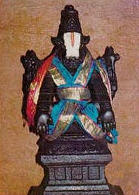
Sri Yoga Narasimhaswami Temple
The sub-temple for Sri Yoga Narasimhaswami, facing the west, is located in a mandapam in the north-eastern corner of the first prakaram. Yoga Narasimhaswami is also known as Girija Narasimhaswami.
The deity of Yoga Narasimhaswami is sculptured according to the Sastras. He is seated with two hands on his knees, and girdled by the Yogapatta.
A ceremonial bath (Tiru-Manjana) is given to the deity in the sanctum on Saturdays; and on the fourteenth day of the bright half of the month of Vaisakha (according to the lunar calendar),Swati Nakshathram the deity is specially worshipped on account of Narasimha Jayanti.
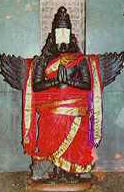
Sri Garuda Temple
The temple of Garuda (also called Garudalwar), is directly opposite the presiding deity in the Sri Venkateswara temple.
Garuda is a faithful devotee of the Lord and he stands with his hands joined in supplication (the Anjali pose). Being the Lord’s mount he is shown with outstretched wings, ever ready to carry him. You will find Garuda’s image not only in the shrine but also at the corners of the prakarams, mandapams and vimanas.
At the commencement of the annual Brahmotsavam of Lord Sri Venkateswara, a flag with the image of Garuda is hoisted on the Dhwajasthamba. It is believed that the Prasadam offered to Garuda in this temple, if partaken, will bless the sterile with children.
Every day, after completing the early morning puja conducted for Lord Sri Venkateswara, the Bali Bera of the Lord is taken out in a palanquin to give offerings to Parivaradevatas. The Lord is believed to personally supervise the food arrangements made for his subordinates, attendants and devotees. The palanquin called Sibika is considered to be Garuda himself. An utsava murti of Garuda is kept in the Ramar Meda along with other bronze images.